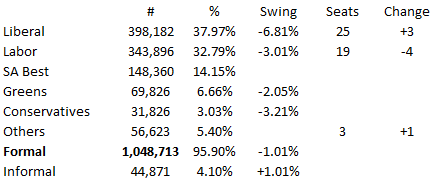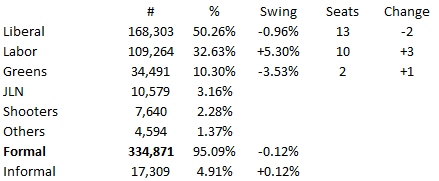Now the dust has settled, a considered review of the three big electoral events of March.
Batman
Labor’s win was ultimately more comfortable than it appeared on election, which has fed into the post-election speculation as to what it all means. For what it’s worth, a ReachTEL poll commissioned by a timber industry lobby group two days out from the election came within one point of accuracy on the two-party vote, and found Adani, health and education each recording about 20% on the question of most important campaign issue.
First the basic results:
A table further below zeroes into the count’s two curiosities, the first of which is the extent of Labor’s surge on late counting. The result is broken down into polling day votes, namely ordinary election day votes, provisional votes and (in the case of the 2016 election, to derive the swing) absent votes; pre-poll, which includes both the pre-poll voting centre booths and declaration pre-polls; and postals, which is just postals.
The fact that Labor didn’t do so well on the day has led suggestions that something must have happened late in the campaign to blunt Labor’s momentum, with the most obvious culprit being Labor’s dividend imputation policy. There may certainly be something in this, but the same pattern was evident in lesser degree at the Northcote by-election, at which the Greens’ swing was 1.9% weaker on pre-polls and 4.4% weaker on postals as compared with polling day votes, with the equivalent differences in Batman being 3.6% and 5.8%.
The second notable feature of the result was the disparity between the Labor-loyal northern end of the electorate and the Greens-leaning south. The former area did actually deliver the Greens the gentle swing they needed to win the seat, while the latter swung solidly to Labor – although there remains a 15.1% differential between the two, compared with 21.5% at the 2016 election. The table separately records votes cast north and south of Bell Street, and excludes votes where this cannot be discerned (postals and such).
South Australia
Counting for the lower house has been finalised, except that we will have to wait a little longer for the definitive statewide two-party preferred result. Labor-versus-Liberal counts are available in 35 seats, but the counts for the other 12 involve SA Best or independents. However, my own rough estimate is that it will come in just about exactly at 52-48 in favour of the Liberals, which represents a 1% swing to Labor compared with 2014. With Labor’s Leon Bignell digging in for a famous 115-vote victory in Mawson, the final party totals are Liberal 25, Labor 19, independents three.
Labor faded worse than usual in late counting, which might yet be of consequence in the upper house. The most likely result remains four seats apiece for Liberal and Labor, two for SA Best and one for the Greens. However, Labor’s weakening position, from 3.56 quotas on the night to 3.46 quotas now, has created a glimmer for Robert Brokenshire of Australian Conservatives, who has held steady on 0.42 quotas. Brokenshire’s opportunities to close the gap on preferences are limited: neither Liberal nor (happily for Brokenshire) the Greens will have a bearing on the result, as their last candidates will not be excluded from the count. That will leave 1.23 quotas from various minnows whose preferences will decide the result.
Most of this vote will exhaust: certainly that will be the case with the 55% who, according to Antony Green, have gone 1-only above-the-line (higher in the case of smaller parties, which is what matters here), and also of much of the 9% below-the-line vote. Even many of the votes that don’t exhaust will have no bearing on the result, as they will be soaked up by the last elected Liberal or the Greens rather than Labor or Brokenshire.
Tasmania
The two close results in Tasmania saw one Greens incumbent hang on, and another go under. These were, respectively, Rosalie Woodruff in Franklin, who won out over the Liberals, and Andrea Dawkins in Bass, who was defeated by Labor. This leaves a final result of Liberal thirteen, Labor ten and Greens two, with Labor gaining three seats off their disastrous 2014 result, including gains from the Liberals in Braddon and Franklin, and from the Greens in Bass. However, the Liberals did extraordinarily well to again record a majority of the primary vote, as illustrated in the summary table below.
In Franklin, a race for the final seat between two incumbents, Rosalie Woodruff of the Greens and Nic Street of the Liberals, was won by Woodruff with a margin of 226 votes (11,362 to 11,136), or 0.019 quotas. This made for a final score of Liberal two, Labor two, Greens one, with Labor gaining a seat from the Liberals. The next closest result was Jennifer Houston’s win for Labor over Andrea Dawkins of the Greens in Bass, where Houston finished with 8207 votes to Dawkins’ 7406, or 0.758 quotas to 0.684. The result from 2014 of Liberal three, Labor one, Greens one thus became Liberal three, Labor two. In Braddon, Labor gained a second seat at the expense of Liberal incumbent Joan Rylah. Labor’s first seat went to a newcomer, Anita Dow, with an incumbent, Shane Broad, holding on for second. This was achieved over Rylah by a margin of 2273 votes, or 0.212 quotas.
Denison was always going to be a repeat of 2014, when Liberal and Labor each won two and the Greens won one. The only question was whether the second Labor seat would go to an incumbent, Madeleine Ogilvie, or a newcomer, Ella Haddad. Haddad finished ahead by 823 votes (9295 to 8472), which was little changed from her 948 vote lead on the primary vote (5288 to 4340). There was also never any doubt about the party result in Lyons, where the Liberals polled nearly exactly three quotas, and Labor nearly exactly two. With three Liberal incumbents re-elected, the point of interest was who would replace the retiring David Llewellyn to join Rebecca White as the second Labor member. This turned out to be Jen Butler, who trailed Janet Lambert by 1783 to 1616 on the primary vote, but prevailed by 7982 to 7621 after preferences.




Thanks for all this BillBowe.
Re Batman, yet another s44-caused by-election where the incumbent party has been returned. Clearly the voters are less worried about s44 breaches than the media and many on here give them credit for.
In South Australia, nothing really happened but everything changed.
There was a slight swing to Labor but it lost government after 16 years. The Libs actually won only one seat off Labor, King, a new electorate with no sitting member. That was balanced by Leon Bignell’s remarkable 115-vote victory in Mawson, which had become notionally solidly Liberal with the addition of conservative Kangaroo Island.
The Lib majority therefore was handed to them by the redistribution commissioners, which turned the Labor-held seats of Elder, Colton, Newland and Mawson into notionally Liberal seats after Labor hung on with 47% of the 2PP vote last time.
Labor was never in the race in Elder and Colton, but had high hopes in Newland where Tom Kenyon had defied the odds before. Not this time.
Mawson apart, Labor’s best hope was Adelaide, where Jo Chapley pushed new minister Rachel Sanderson to the wire but could not quite overcome the addition of blue-blooded Walkerville to the seat.
On the face of it, new Liberal candidate Stephen Patterson bolted home in Colton, but if Labor had run just a little dead the deselected, discontented former Lib MP Duncan McFettridge would have retained the seat. He needed only about 300 votes to finish ahead of Labor and coast in on preferences.
Don’t know where you get that 300 figure from. McFetridge was 2,152 votes behind Labor at the last exclusion. McFetridge received less than half of the preferences from the exclusion of Dignity, Green and SA Best candidates.
The Greens lost a seat overall in Tasmania – in your table you said they gained +1
The SA result has set Labor up well for the next election- they will only need a small swing. Couldn’t really ask for much more after 4 four-year terms.
BUT they really did deserve to win.
Am I reading the Batman table correctly, Labor did slightly better on polling day than in pre-polls, but both were far worse than postal votes? Seems like a simple explanation to me, Labor picked up the elderly postal votes from the Liberals and the Greens’ opposition to dividend imputation changes hurt them slightly in such a progressive seat.
The 2016 federal election was in school/university holidays, so one would expect that postal/pre-poll voters in Batman would have skewed younger (and therefore more Greens-friendly) as a group in 2016 than was the case this time.
It would appear that my information was badly flawed, Antony. My friend in Morphett said that preferences from everyone were flowing strongly to McFettridge. Apologies to all.
Final first preference figures up for Leg Council. Little change on Labor/Conservatives gap.
See Matt April 1., 11.20 am. Bludger, Are you a captive of Green brainwashining to the effect that you have removed the minus key from your keypad when entering swings or seat totals for The Greens? It may be needed for Batman, South Australia, Greg Barbarous’s Council seat in Victorial Legislature,….